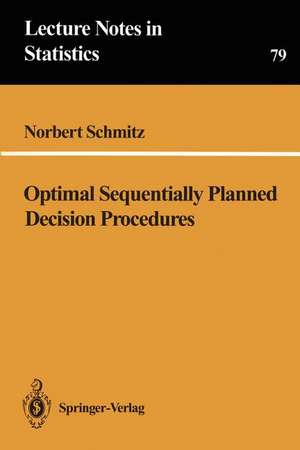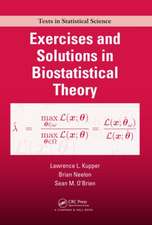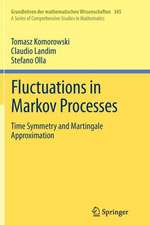Optimal Sequentially Planned Decision Procedures: Lecture Notes in Statistics, cartea 79
G. Duscha Autor Norbert Schmitz J. Lübbert, T. Meyertholeen Limba Engleză Paperback – 28 oct 1992
Din seria Lecture Notes in Statistics
- 15%
 Preț: 631.86 lei
Preț: 631.86 lei -
 Preț: 385.84 lei
Preț: 385.84 lei - 17%
 Preț: 490.19 lei
Preț: 490.19 lei - 17%
 Preț: 460.28 lei
Preț: 460.28 lei - 18%
 Preț: 945.92 lei
Preț: 945.92 lei - 20%
 Preț: 561.42 lei
Preț: 561.42 lei - 18%
 Preț: 943.25 lei
Preț: 943.25 lei - 18%
 Preț: 943.25 lei
Preț: 943.25 lei - 18%
 Preț: 990.57 lei
Preț: 990.57 lei - 15%
 Preț: 641.38 lei
Preț: 641.38 lei -
 Preț: 436.14 lei
Preț: 436.14 lei - 15%
 Preț: 633.53 lei
Preț: 633.53 lei - 15%
 Preț: 658.88 lei
Preț: 658.88 lei -
 Preț: 383.33 lei
Preț: 383.33 lei - 15%
 Preț: 640.71 lei
Preț: 640.71 lei - 18%
 Preț: 947.18 lei
Preț: 947.18 lei - 18%
 Preț: 1007.35 lei
Preț: 1007.35 lei - 18%
 Preț: 942.63 lei
Preț: 942.63 lei - 15%
 Preț: 639.59 lei
Preț: 639.59 lei - 18%
 Preț: 1231.47 lei
Preț: 1231.47 lei - 15%
 Preț: 643.00 lei
Preț: 643.00 lei - 18%
 Preț: 886.62 lei
Preț: 886.62 lei -
 Preț: 383.12 lei
Preț: 383.12 lei - 15%
 Preț: 633.35 lei
Preț: 633.35 lei - 15%
 Preț: 635.65 lei
Preț: 635.65 lei -
 Preț: 393.74 lei
Preț: 393.74 lei - 15%
 Preț: 632.70 lei
Preț: 632.70 lei - 15%
 Preț: 637.28 lei
Preț: 637.28 lei - 15%
 Preț: 702.87 lei
Preț: 702.87 lei - 15%
 Preț: 642.68 lei
Preț: 642.68 lei - 15%
 Preț: 644.63 lei
Preț: 644.63 lei - 15%
 Preț: 645.14 lei
Preț: 645.14 lei -
 Preț: 382.36 lei
Preț: 382.36 lei - 15%
 Preț: 636.30 lei
Preț: 636.30 lei - 15%
 Preț: 647.92 lei
Preț: 647.92 lei -
 Preț: 380.63 lei
Preț: 380.63 lei - 18%
 Preț: 887.05 lei
Preț: 887.05 lei - 15%
 Preț: 634.32 lei
Preț: 634.32 lei - 15%
 Preț: 648.74 lei
Preț: 648.74 lei -
 Preț: 378.92 lei
Preț: 378.92 lei - 15%
 Preț: 648.56 lei
Preț: 648.56 lei - 15%
 Preț: 647.59 lei
Preț: 647.59 lei - 18%
 Preț: 780.37 lei
Preț: 780.37 lei - 15%
 Preț: 641.20 lei
Preț: 641.20 lei - 18%
 Preț: 1102.69 lei
Preț: 1102.69 lei - 15%
 Preț: 643.16 lei
Preț: 643.16 lei -
 Preț: 384.70 lei
Preț: 384.70 lei
Preț: 637.13 lei
Preț vechi: 749.56 lei
-15% Nou
Puncte Express: 956
Preț estimativ în valută:
121.91€ • 127.04$ • 100.94£
121.91€ • 127.04$ • 100.94£
Carte tipărită la comandă
Livrare economică 03-17 aprilie
Preluare comenzi: 021 569.72.76
Specificații
ISBN-13: 9780387979083
ISBN-10: 0387979085
Pagini: 207
Ilustrații: XII, 207 p.
Dimensiuni: 155 x 235 x 12 mm
Greutate: 0.33 kg
Editura: Springer
Colecția Springer
Seria Lecture Notes in Statistics
Locul publicării:New York, NY, United States
ISBN-10: 0387979085
Pagini: 207
Ilustrații: XII, 207 p.
Dimensiuni: 155 x 235 x 12 mm
Greutate: 0.33 kg
Editura: Springer
Colecția Springer
Seria Lecture Notes in Statistics
Locul publicării:New York, NY, United States
Public țintă
ResearchCuprins
I. Introduction.- § 1 Sequential statistical procedures.- § 2 Objectives of sequential analysis.- § 3 Historical remarks on the development of sequential analysis.- § 4 Examples of sequential procedures; purely sequential statistical decision procedures.- § 5 Objections to purely sequential statistical decision procedures.- § 6 Sequentially planned statistical procedures.- II. Optimal sequential sampling plans.- § 1 Problems of optimal sampling.- § 2 Optimal sampling plans for finite horizon.- § 3 Existence of optimal sampling plans for general A.- § 4 Optimal sampling plans for the Markov case.- III. Sequentially planned tests; sequentially planned probability ratio tests.- § 1 Notation.- § 2 The iid case.- § 3 Sequentially planned probability ratio tests.- § 4 Algorithms for computing the OC- and ASC-function of SPPRT’s in the iid case.- § 5 Remarks on the implementation of the algorithms; Examples.- § 6 Remarks on the comparison of the methods and on convergence-improvements for the BF-/EV- method.- IV. Bayes-optimal sequentially planned decision procedures.- § 1 Introduction.- § 2 Bayes-procedures.- § 3 A posteriori-distributions.- § 4 Bayes-optimal sampling plans; Markov case.- V. Optimal sequentially planned tests under side conditions.- § 1 Decision problems with side conditions.- § 2 Characterizations of optimal sequentially planned decision procedures.- § 3 Sequentially planned tests for simple hypotheses in the iid case.- § 4 The modified Kiefer-Weiss problem in the iid case.- § 5 Locally optimal sequentially planned tests in the dominated iid case.- § 6 Remarks on the monotonicity of the power functions of SPPRT’s and GSPPRT’s.- Appendix A: Mathematical models for sequentially planned sampling procedures.- § A.1 The concept ofpolicies by Mandelbaum and Vanderbei.- § A.2 The concept of tactics by Krengel and Sucheston.- § A.3 The concept of decision functions by Washburn and Willsky.- § A.4 The concept of stopped decision models by Rieder.- Appendix B: Implementation of the algorithms EV, BF and ILE; Diophantine Approximation.- § B.1 Listing of the modules.- § B.2 Diophantine approximation.- Appendix C: References, Bibliography.
















